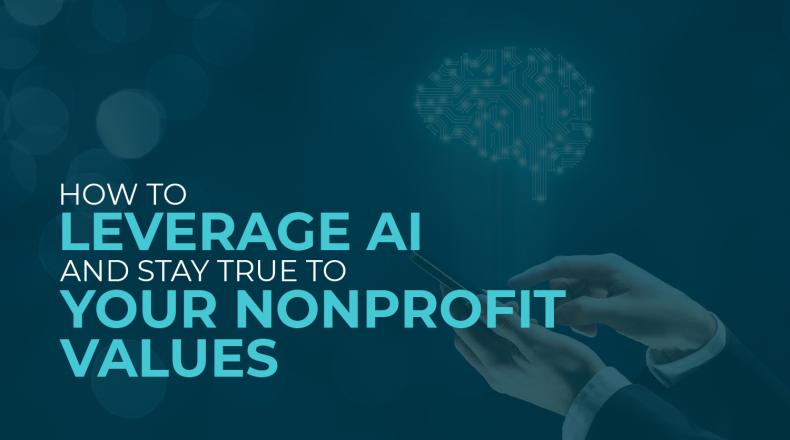How to Leverage AI and Stay True to Your Nonprofit Values

As a nonprofit professional, you understand the importance of keeping up with the latest tech trends. For example, over the last decade or so, you’ve likely embraced the art of online fundraising or text-to-give. During the COVID-19 pandemic, you learned to pivot your fundraising events to virtual spaces and use tech in other ways to engage your community from afar.
Now, artificial intelligence (AI) is all the rage, making headlines nearly every day as optimistic proponents announce exciting use cases and others warn of potential pitfalls and ethical issues. Amid this swirl of updates and opinions, it can be tricky to know where you should stand when it comes to using AI in nonprofit work. After all, you have beneficiaries, supporters, and your organization’s future to think about!
However, the fact of the matter is that AI isn’t going everywhere. And, the general consensus among fundraising experts is that it’s time for nonprofits to embrace it—with one major caveat: Your nonprofit must learn how to use AI while staying true to its values. In this guide, we’ll help you get started by exploring four strategies your organization can adopt to use AI in a responsible and ethical way. Let’s dive in.
1. Review your organization’s mission, vision, and values.
As is the case when adopting any new technology or shift in strategy, you should begin your journey to using AI successfully by reviewing your nonprofit’s values and priorities.
Though you probably know your mission by heart, start with your mission and vision statements. Drill down into what you’re trying to accomplish for your community and consider how AI could help. For instance, your organization might focus on providing school clothes to children in need. AI could help you find more major donors to expand your programs.
Next, look over your organization’s key values. Here are some common nonprofit values and how they can translate into using AI responsibly:
- Compassion: When you use AI, prioritize the well-being of your beneficiaries, donors, volunteers, and other community members. Operate from a place of recognizing their most pressing needs and meeting them.
- Inclusivity and diversity: Commit to using high-quality, accurately representative data to mitigate bias and reduce the risk of perpetuating discrimination. Only work with vendors that hold themselves to the highest standards.
- Innovation: Become a student of AI, keeping up with developments in AI technology and paying attention to the regulatory landscape that your nonprofit is operating in. Use AI to do good in more efficient and creative ways.
As you root your AI adoption efforts in what your nonprofit stands for and works toward, you’ll find it much easier to use AI in ways that protect your organization from risk and truly benefit your community.
2. Commit to the responsible use of AI.
To further align your AI strategy with your nonprofit’s key values, you can also look to those who are leading the charge of using AI responsibly.
For example, Fundraising.AI is an independent collaborative that was created to empower fundraisers with the tools and knowledge they need to use AI ethically. Here are the main tenets of the organization’s Responsible AI Framework, as explained in DonorSearch’s guide to responsible AI:

1. Privacy and Security
2. Data Ethics
3. Inclusiveness
4. Accountability
5. Transparency and Explainability
6. Continuous Learning
7. Collaboration
8. Legal Compliance
9. Social Impact
10. Sustainability
These tenets, coupled with your organization’s existing values, provide a strong foundation for learning about AI, strategizing about how it can make a difference to your nonprofit, and successfully integrating it into your operations.
3. Choose your AI tools with care.
While the way your nonprofit thinks about and approaches AI is critical for successful implementation, it won’t be the only perspective that matters. The AI vendors you partner with will also have a major impact on how well your organization can use AI in a way that aligns with its values.
Here are a few tips to consider when shopping for an AI tool and vetting vendors:
- Do your research. On top of exploring vendor websites and case studies, you can also check out software review websites like G2 to get more objective insights on each tool and company. Also, if you know a colleague in the nonprofit space is working with a vendor you’re considering, don’t be afraid to reach out and ask them for their thoughts.
- Inquire about their ethics. Create a list of questions to learn about how vendors keep data secure, how they address issues like bias or unfairness, and what they’re doing to keep up with the evolving regulatory landscape for AI.
- Ask for demos. Before investing in a tool, get a demo to see it in action. This will help you to better evaluate not only the vendor’s commitment to using AI in ethical ways but will also help you see if the tool is truly a good fit for you.
Another important consideration when assessing vendors is their commitment to innovation. You don’t want an AI tool that will have a hard time keeping up with evolving best practices. Make sure the company you partner with is dedicated to improving over time and keeping up with new developments!
4. Be transparent with your community.
Once you’ve successfully integrated your AI tool into your operations, keep your community informed about how you’re making the most of this new technology. Since nonprofit work is all about building and maintaining relationships, make sure that those who support you and benefit from your work don’t feel like they’re kept in the dark about how you’re using AI.
Here are a few suggestions for how you can be transparent with your community about AI:
- Send out a newsletter announcing your adoption of AI and clearly explain how you’re using your new tool.
- Publish your AI policies and guidelines on your website.
- Get informed consent from all of your supporters before using their data with an AI tool.
- Provide information about your chosen vendor(s), such as how their values align with your nonprofit’s and what kind of access they have to supporter data.
- Share the positive impact AI tools are having on your operations.
- Seek feedback and input from stakeholders on how you’re using AI.
Your donors, volunteers, beneficiaries, and other members of your community are also aware of the current buzz surrounding AI, so there’s no doubt they’ll be curious to see how your nonprofit handles its new technology. Each time you provide an update, remember to include your organization’s contact information should individuals want to reach out with any questions or comments regarding your use of AI.
No matter what the headlines have to say about AI, the truth is that it’s here to stay and your nonprofit can benefit from it when used correctly!
Leverage these strategies to begin reflecting on how your organization can use AI in a way that aligns with your core values, and then you’ll be ready to begin the exciting process of adopting AI tools into your fundraising work.
 Sarah Tedesco is the Executive Vice President of DonorSearch, a prospect research and wealth screening company that focuses on proven philanthropy. Sarah is responsible for managing the production and customer support department concerning client contract fulfillment, increasing retention rate and customer satisfaction. She collaborates with other team members on a variety of issues including sales, marketing and product development ideas.
Sarah Tedesco is the Executive Vice President of DonorSearch, a prospect research and wealth screening company that focuses on proven philanthropy. Sarah is responsible for managing the production and customer support department concerning client contract fulfillment, increasing retention rate and customer satisfaction. She collaborates with other team members on a variety of issues including sales, marketing and product development ideas.




